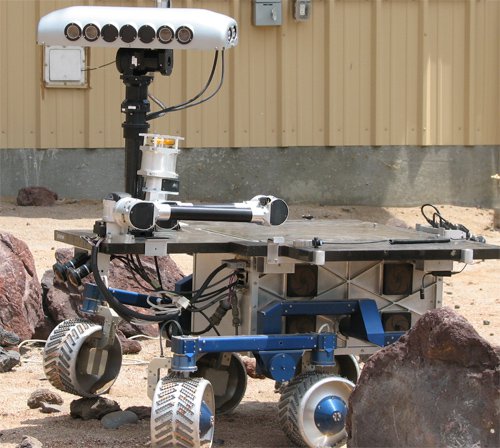
The Rover Research Test Bed.
The Research Rover Test bed task seeks to refurbish the Athena rover as part of a JPL Strategic Research and Technology Development Program initiative that investigates rover autonomy for multi-sol operations. Such operations are motivated by limited rover productivity and communication constraints of future orbiters.
The refurbishment of the rover includes mechanical, avionics and software upgrades. The mechanical upgrade includes a replacement of the actuators and a redesign of the gear trains to support higher rover speeds that would accelerate the development and testing of autonomous capabilities. The drive speed will be increased by an order of magnitude while the steering by fourfold. The mast pan/tilt speeds will also be increased by fourfold. The arm refurbishment is not within the current scope of the current task.
On the avionics side, the rover upgrades include a new computational stack, power system, and the motor control. The computational stack will have two processor boards: (a) an NVIDIA Jetson TK1 ARM Cortex-A15 quad-core CPU with 192-core Kepler GPU and (b) NVIDIA Jetson TX1 64-bit ARM A57 CPU with 256-core Maxwell GPU. The TK1 will be used for system functions, motion planning and control software, while the TX1 will be used for vision processing that include stereovision perception and visual odometry pose estimation. The cameras will use black and white PointGrey Flea 2 1394b with new USB3 color panoramic cameras. The motor control will use the P3 controllers from Barrett Technology. These controllers, which are the diameter of a penny, are distributed and integrated with the drive, steering and mast motors. The power system will provide based of 48 V to support the new actuators.
On the software side, the rover will use an updated version of the CLARAty software integrated with ROS nodes for distributed computing. The perception system will provide stereovision and visual odometry individually at frame rate and combined at ~20 Hz for 512 x 384 images. The mobility system will provide position (arc-based) and velocity commanding. It will support Ackermann and all-wheel continuous maneuvering. The navigation software will support grid-based navigation algorithms for traversability analysis and arc-based maneuvers (derivatives of GESTALT and Mars 2020).
People on this Task
Neil Abcouwer


